The missile potential of the Islamic Republic of Iran (Part 3)
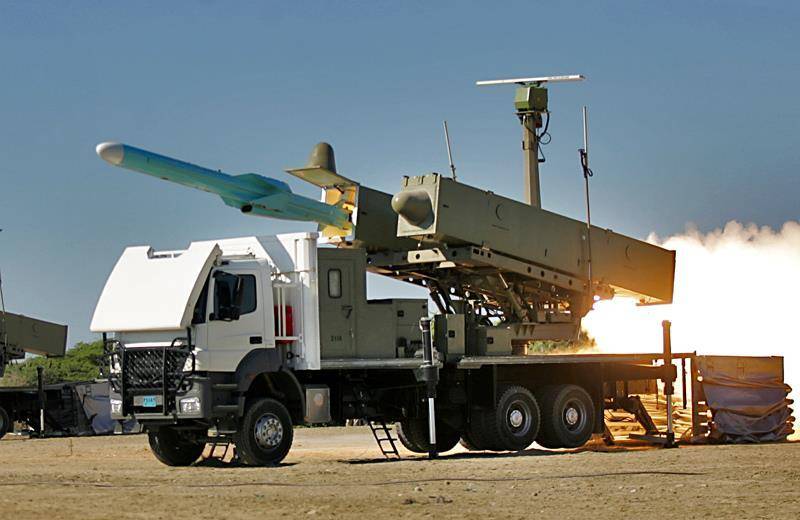
In addition to the development of ballistic missiles in Iran, a lot of attention is paid to anti-ship missile systems. On the basis of the Fateh-110 operational tactical complex, the Khalij Fars ballistic anti-ship missile, first introduced in the 2011, was created. The CRP was initially launched from the same launchers as the Fateh-110 OTR. Later during the exhibition of military equipment in the square of Baharestan in Tehran, a towed launcher for three missiles was demonstrated.
The declared range of the Khalij Fars anti-ship complex is 300 km. The speed of a rocket carrying a warhead weighing 650 kg in the lower part of the trajectory exceeds 3M. On American cruisers and destroyers, such targets can intercept only SM-3 or SM-6 anti-aircraft missiles used in the Aegis system.
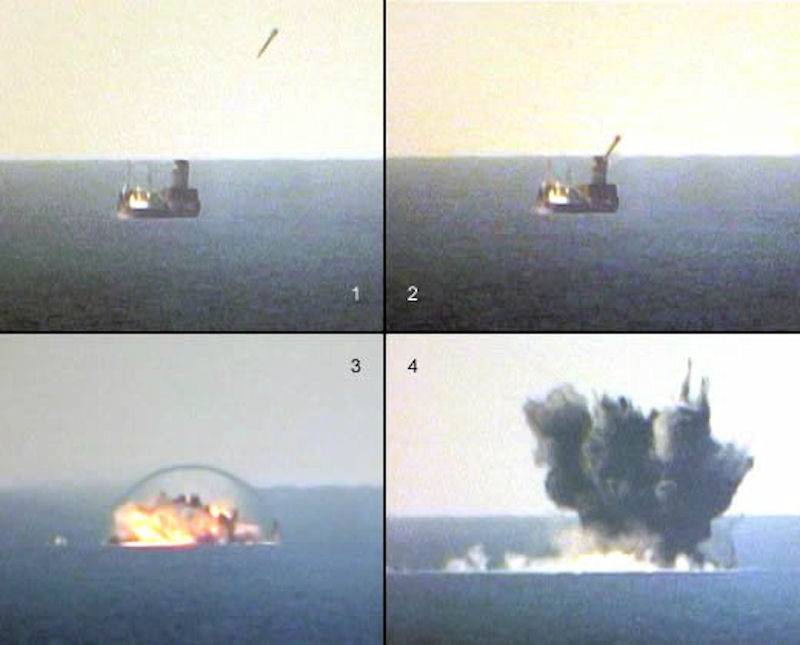
The ballistic anti-ship missile, whose name translates as “Persian Gulf”, is controlled by an inertial system on the main part of the flight. The final descending branch of the trajectory is guided by an infrared homing head that responds to the thermal signature of the ship or with the help of a television radio command guidance system. Foreign observers point out that these guidance systems are highly susceptible to organized interference and can be effective mainly against slow civilian ships. It is expected that in the near future, Iranian ballistic missiles can be equipped with active radar seeker.
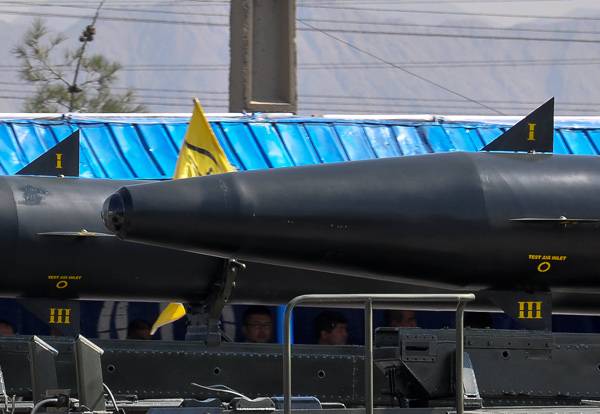
During the exercises, the Navy and the coastal defense forces of Iran Khalij Fars missiles repeatedly hit training targets. It is reported that in the latest versions, the accuracy of the hit is increased to 8,5 meters. In addition to Iran, only China has ballistic anti-ship missiles. However, it is not correct to compare Chinese and Iranian missiles, since the Chinese DF-21D ballistic missile is much heavier and has a launch range of about 2000 km.
Virtually all Iranian anti-ship missiles have Chinese roots. During the Iran-Iraq war, Iran acquired the coastal systems C-201 with HY-2 missiles. RCC HY-2 was actually a copy of the Soviet P-15M. But due to the increased fuel tanks, which led to an increase in weight and size, could only be used on the coast. Anti-ship missiles, which received the designation "Silkorm" in the West (eng. Silk Warm - Silkworm), were actively used during hostilities. At the end of 80's, Iran launched the production of HY-2G missiles.
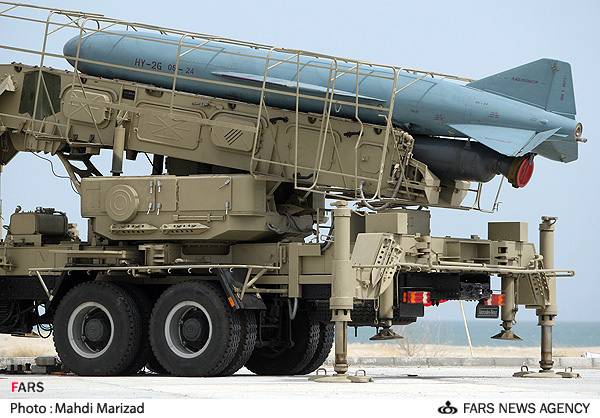
The HY-2A missile was equipped with an infrared HOS, and the HY-2B and HY-2G - with a single-pulse radar HH, HY-2С - with a television guidance system. The HY-2G modification, thanks to the use of an improved radio altimeter and a programmable controller, made it possible to use a variable flight profile, which made it difficult to intercept. The probability of hitting a target in the event of its capture by a radar homing vessel in the absence of organized interference and fire counteraction was assessed - 0,9. The launch range is within 100 km. Despite the fact that the rocket carries a heavy armor-piercing high-explosive warhead weighing 513 kg, due to subsonic flight speed and low noise immunity of active radar seeker, its effectiveness in modern conditions is not great. In addition, during the refueling of the rocket, the calculation is forced to work in protective suits and insulating gas masks.
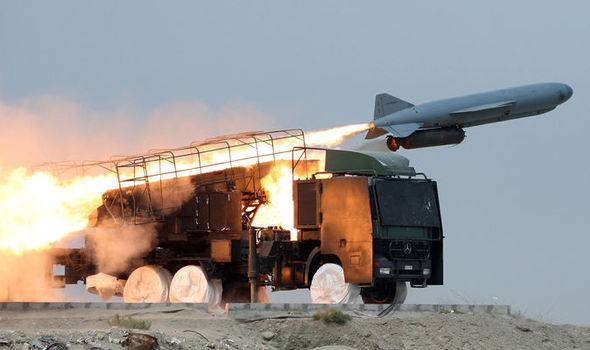
This shortcoming was eliminated in the HY-41 (C-201W) modification, in which the WS-11 compact turbojet engine was used instead of the LRE. This turbojet engine is a clone of the American Teledyne-Ryan CAE J69-T-41A, which was installed on AQM-34 reconnaissance UAVs during the Vietnam War. Before Vietnamese-Chinese relations were damaged, several not too damaged American drones sent to China. The HY-4 anti-ship missile, put into service in 1983, is a combination of guidance and control systems from the HY-2G anti-ship missiles with the WS-11 turbojet engine. The rocket is launched using a detachable solid propellant booster. The range of destruction of sea targets is 300 km.
Quite expectedly, Iran after HY-2G got HY-41 missiles. In 2004, the public was presented a similar Iranian-made Raad missile on a tracked self-propelled launcher. Externally, the new rocket differs from the HY-2G air intake and a different form of tail and wing layout. Despite the fact that the service and operational characteristics of the missile and the range have seriously improved, it does not exceed the outdated HY-2G in flight speed and noise immunity. In this regard, the number of constructed RPC "Raad" is relatively small. It was reported that in Iran, for the “Raad”, a new noise-suppressing GOS was developed, capable of conducting a search for a target in the sector of +/- 85 degrees. The launch of the missile to the attack area is carried out by signals from a satellite navigation system.
But, despite all the tricks, the rockets created on the basis of the technical solutions of the Soviet anti-ship missile system P-15, which was put into service in the 1960 year, are undoubtedly outdated today and do not correspond to modern realities. For this reason, they are actively used in exercises to simulate air targets. In the past, it was reported that a cruise missile designed to destroy ground targets was launched on the basis of the Raad anti-ship missile defense, but this was not confirmed. The Iranian "Raad" on tracked SPU is very much like the North Korean anti-ship complex KN-01, also created on the basis of П-15М. Given the fact that Iran and the DPRK in the past very closely cooperated in the creation of ballistic missiles, it can be assumed that this Iranian modification was created with the help of North Korea.
At the beginning of the 80-x between China and Western countries against the background of the confrontation of the USSR there was a rapprochement. In addition to political contacts and the development of a unified anti-Soviet position, China gained access to some modern weapons systems. No doubt, the creation of a new solid-fuel anti-ship missile was not without foreign assistance. The transition from liquid rockets, created by 50-s technologies, to rather compact anti-ship missiles with modern radar homing and a mixed-fuel engine was too striking. In the second half of the 80-x, the YJ-8 (C-801) rocket was put into service, its characteristics close to the first versions of the Exocet anti-ship missiles. In this case, the Chinese rocket began to be delivered to the troops in just 10 years after the French counterpart. In the middle of the 90's, about 100 C-801K export anti-ship missiles, intended for use with combat aircraft, were sold to Iran. These missiles with a launch range of about 80 km armed fighter-bombers F-4E.
With all its advantages, solid-fuel missiles, as a rule, are inferior in launch range to missiles with direct-flow and turbojet engines. Therefore, using the aerodynamic scheme and guidance system YJ-8 was created YJ-82 (C-802) with a compact turbojet engine. The range of the new rocket has more than doubled. The first C-802 anti-ship missiles came to Iran in the middle of the 90's, along with Chinese-made missile boats. Soon, Iran started an independent assembly of missiles, designated Noor.
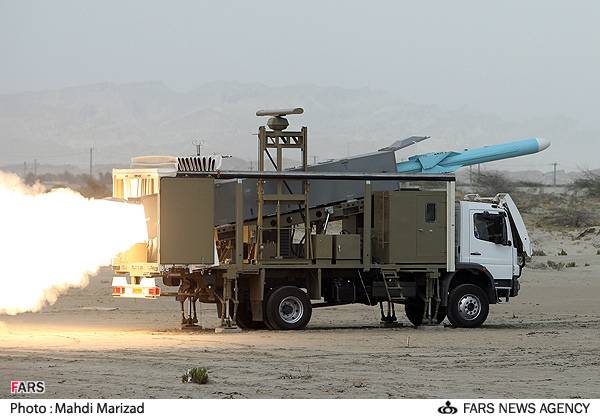
An NUR missile with a starting mass of just over 700 kg carries a 155 kg warhead. The launch range is up to 120 km, the maximum speed is 0,8 M. In the final phase, the flight height is 6-8 meters. The rocket has a combined guidance system, autonomous inertial is used on the cruising flight segment, and active radar homing is on the final segment. Rockets of this type are widely used in the Iranian armed forces, practically ousting early, less sophisticated models.
PKR "Nur" are used on Iranian warships and rocket boats. But most of them are located on mobile launchers of coastal missile systems. Trucks with paired or built-in transport and launch containers can be quickly transferred to any point of the Iranian coast. In the transport position, missile complexes on a truck chassis are usually covered with an awning and practically indistinguishable from ordinary trucks. In terms of weight and dimensions, range and speed of flight, the anti-ship missiles YJ-82 and “Nur” are in many respects similar to the American RGM-84 Harpoon, but it is not known how the noise immunity characteristics and selectivity correspond to the American model.
In the spring of 2015, at the exhibition of achievements of the Iranian military industrial complex, the Mi-171 helicopter of the Iranian Navy with two suspended Nur missiles was demonstrated.
In 1999, the PCR YJ-83 (C-803) was introduced in China. It differs from YJ-82 by increased dimensions and weight, and increased flight range to 180 km (250 km in the case of use from an aircraft carrier). The new rocket has a more economical turbojet engine, a larger fuel tank and an armor-piercing high-explosive warhead weighing 185 kg.
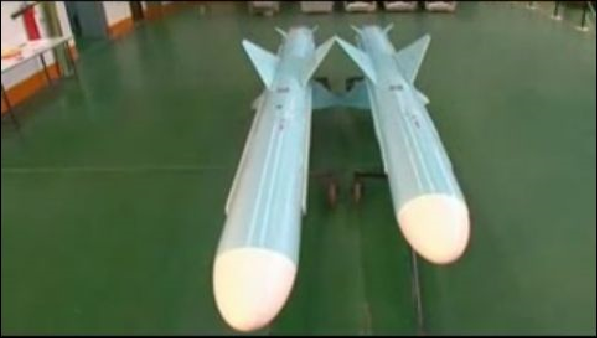
Somewhere in 2009, in the Islamic Republic, the assembly of YJ-83 rockets began. RCC, which received the designation Ghader, is used mainly in mobile coastal missile systems and as part of the weapons of the not numerous Iranian Phantoms. Visually, the Nur and Gader missiles differ in length.
Anti-ship missiles "Nur" and "Gader" are quite modern means of combating surface targets, and quite legally are the pride of the Iranian military. Surface ships and land mobile complexes equipped with these missiles are today the most combat-ready part of the coastal defense forces.
In September 2013, it was also officially unveiled. aviation RCC version "Gader". Missiles were included in the armament of the F-4E Iranian Air Force. However, in a flying state in Iran, today there are three dozen heavily worn out "Phantoms" who, of course, do not particularly influence the balance of power in the region.
During the years of the Shah’s rule, Iran was one of the closest allies of the United States, and supplies of the most modern weapons western production. Including up to 1979, Iran purchased the US RGM-84A Harpoon, AGM-65 Maverick and Italian Sea Killer Mk2 missiles.
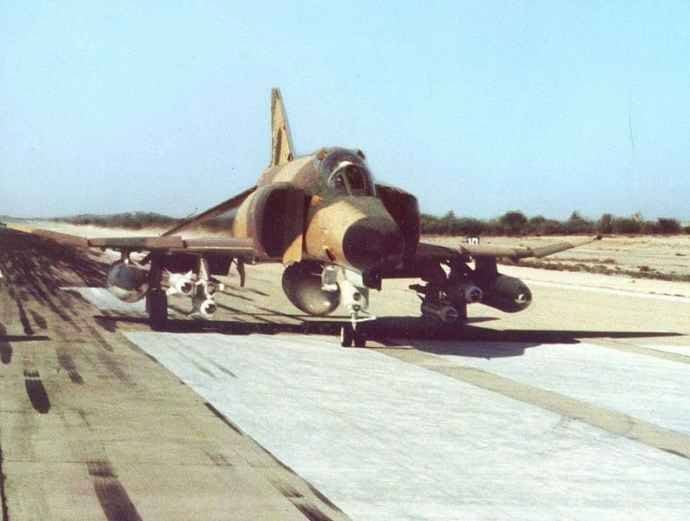
Iranian F-4D Phantom II fighter-bomber with AGM-65 Maverick missiles preparing for combat sortie
For the end of the 70's, this was the latest weaponry. PKP "Harpoon" carried the missile boats of French construction type Combattante II. Italian missiles were armed with frigates of the English type Vosper Mk.5, and the Maveriki were part of the armament of the F-4D / E Phantom II fighter-bomber.
Western missiles were actively used in the course of hostilities. But as the reserves were used up and out of order due to lack of service, China became the main supplier of rocket technology. Most of the missile arsenal purchased by the Shah turned out to be practically spent by 20 in August 1988, when an armistice was concluded between the parties. At the beginning of 90-x several copies of missiles in the framework of military-technical cooperation were transferred to the PRC. In China, these rockets served as an inspiration for creating several short-range RCC models.
Based on the Italian Sea Killer missile, Chinese experts designed the FL-6 anti-ship missiles. These relatively compact and inexpensive missiles are designed to combat mosquito ships fleet»With a displacement of up to 1000 tons and counteraction to landing operations in the coastal zone. Just like the Italian prototype, the launch range of the FL-6 is in the range of 25-30 km. Missiles can be equipped with a television or infrared seeker. With a starting weight of 300 kg, the rocket carries 60 kg warhead.
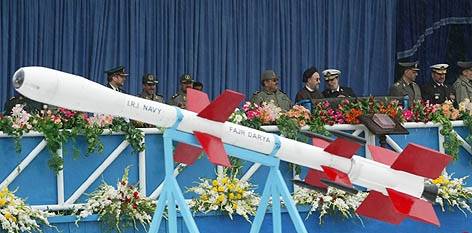
Chinese FL-6 received the designation Fajr Darya in Iran. These missiles were not widely spread: the only known carriers of the Fajr Daria are the SH-3D "Sea king" helicopters.
In the People's Republic of China, on the basis of the AGM-65 Maverick air-to-missile rocket, at the end of the 90-x, a light YCR-7T (C-701T) RCC was created. The first modification had an IR GOS, a launch weight of 117 kg, a warhead with a mass of 29 kg and a range of 15 km. Flight speed - 0,8М. Unlike the American prototype, the Chinese rocket has a wide range of carriers: airplanes and helicopters, light boats and automobile chassis. The launch range of the first model was limited by the low sensitivity of the thermal homing head. Subsequently, this deficiency was eliminated and the missile reach was able to reach km 20-25, depending on the type of target. The same range has a modification of the YJ-7R (C-701R) c semi-active radar seeker.
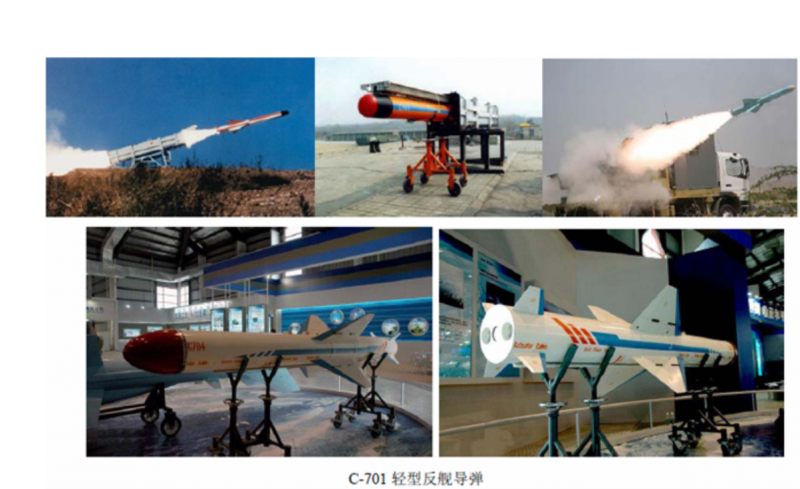
In the 2008, at the Zhuhai Air Show, new modifications with 35 km launch range were demonstrated: YJ-73 (C-703) with a radar semi-active GOS of millimeter range, and YJ-74 (C-704) television guidance system. The YJ-75 RCC (C-705) with a centimeter-range radar seeker is equipped with a compact turbojet engine, which made it possible to bring the launch range to 110 km. Until the target is captured by the active radar head, the missile heading is adjusted according to the signals of the satellite positioning system. It is reported that, in addition to sea, missiles can be used against ground targets.

YJ-7T and YJ-7R models are manufactured in Iran under the name Kowsar-1 and Kowsar-3. The advantage of these missiles are relatively low cost, compactness, as well as weight and dimensions, allowing the missiles to be moved without the use of mechanized loading means. They are used in the composition of mobile coastal complexes, are part of the armament of Iranian fighters and helicopters.
Gathering material about Iranian anti-ship missiles is hampered by the fact that in different sources the same models often appear under different names. In addition, the Iranians themselves love to assign new designations to slightly modified samples. Apparently, the new Iranian anti-ship missile Zafar, presented in 2012, is a copy of the YJ-73.
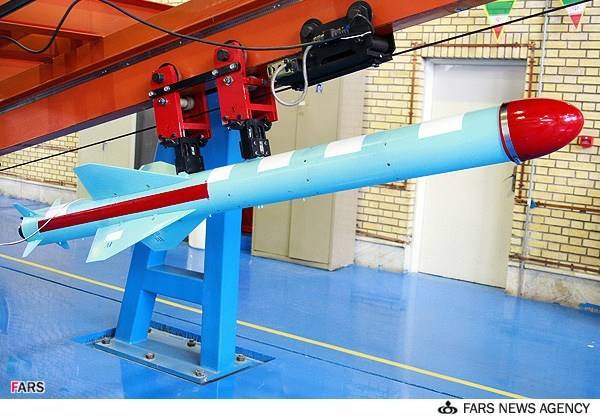
The Nasr-1 missiles with a millimeter-range radar homing missile belong to the same family. It seems that this RCC was specially developed in the PRC by the Iranian order on the basis of the French AS.15TT Aérospatiale. In China, the rocket, which received the designation TL-6, was not accepted for service and is offered only for export.

Mass production of Nasr-1 missiles in Iran began after 2010. This rocket is mainly intended for armament of small rocket boats and use in coastal complexes. With a launch range and flight speed comparable to Kovsar-3, the weight of the Nasr-1 warhead was increased to 130 kg, which poses a threat to warships with a displacement of 4000 tons.
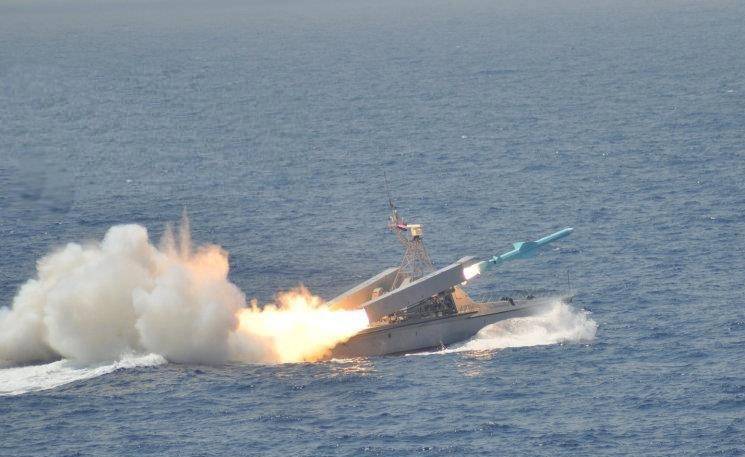
On the basis of the rocket Nasr-1 created RCC Nasir. The rocket was first demonstrated at the start of 2017. According to Iranian data, the Nazir launch range is more than doubled compared to the Nasr-1 RCC.
It is not entirely clear how the Iranians managed to achieve such a significant increase in range. The photographs show that the Nazir missile received an additional accelerating stage, but the air intakes necessary for the operation of the turbojet engine are not visible.
In April 2017, the Ministry of Defense and Logistics of the Iranian Armed Forces handed over to the Navy the Islamic Revolutionary Guard Corps a batch of new Nazir anti-ship missiles. The ceremony was attended by Defense Minister Brigadier General Hossein Dekhan and Navy Commander Rear Admiral Ali Fadavi.
Anti-ship missiles, obtained and created with the help of China, were shipped from Iran to Syria and the Lebanese Shiite group Hezbollah. Apparently, the Israeli intelligence during the preparation of the operation “Worthy retribution” in 2006 failed to reveal in time the fact that the guerrilla armed group had anti-ship missiles. 16 July 2006, the corvette of the Israeli Navy "Hanit", who participated in the blockade of the Lebanese coast, in 8 hours 30 minutes local time was subjected to a rocket attack.
The warship, stationed 16 km from the coast, was hit by an anti-ship missile. At the same time killed four Israeli naval sailors. The corvette itself and the helicopter on board were seriously damaged. Initially it was reported that the Chinese-made RCC C-802 got into the ship. The rocket hit hit the crane installed in the stern of the ship. As a result of an explosion under the helipad, a fire broke out, put out by the crew.
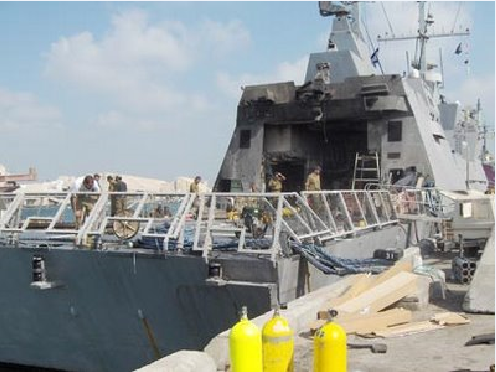
However, in the case of hitting an unarmored ship with a 1065 tonnes displacement, a sufficiently large 715 kg missile with a warhead weighing 165 kg would have been much more serious. As you know, the C-802 CRP uses a turbojet engine, and if the intended CRP type is used, kerosene unspent in flight would inevitably cause a large-scale fire. In addition, there was no need to use a rocket with a launch range of more than 120 km against the ship, which is actually in the line of sight. Most likely, according to the Israeli corvette, Shiite fighters launched an easy anti-ship missile system of the YJ-7 family with a radar or television guidance system.
During the missile attack on the corvette, radar jamming systems and airborne target detection radar were turned off, which did not allow for the necessary protection measures to be taken. After the fire was extinguished and the struggle for survivability was completed, the ship remained afloat and was able to independently get to the territorial waters of Israel. Subsequently, more than $ 40 million was spent on the restoration of the corvette. By and large, Israeli sailors were very lucky, since the rocket did not hit the most vulnerable part of the warship.
The fact that a light "guerrilla" anti-ship missile was used against the Khanit corvette was confirmed in March 2011, when the Israeli Navy stopped the Victoria cargo ship in the 200 miles off the coast of Israel, flying the Liberian flag to Alexandria in Egypt. During inspections on board the ship, a cargo of weapons weighing 50 tons, including the anti-ship missile YJ-74, was detected.
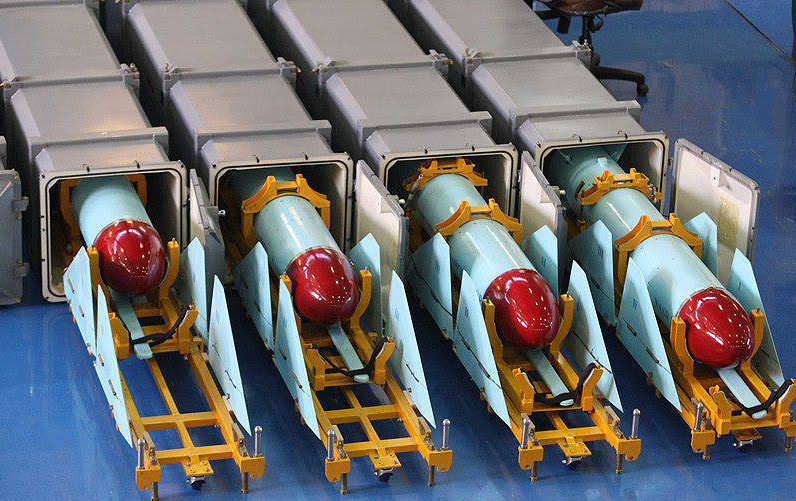
A number of sources indicate that the US Navy "Harpoon" is still used in the Iranian Navy. It is difficult to say how realistic this is, since more than 40 years have passed since their delivery to Iran. Even if the American anti-ship missiles were not expended during the hostilities, they repeatedly delayed the period of guarantee storage. It is possible that Iran has managed to establish the repair and maintenance of missiles. At least, until recently, it was possible to observe the PU “Garpun” anti-ship missiles on Iranian La Combattante II type launch boats. Iranian representatives in the past have stated that they have managed to create their own version of the Harpoon RCC, but so far there is no evidence of this.
Assessing the potential of Iranian anti-ship missiles, we can note their heterogeneity. As in the case of ballistic missiles, in the Islamic Republic at the same time, several samples of similar characteristics, which are radically different from each other, are being developed and put into service. This approach makes it difficult to prepare rocket calculations, seriously increases the cost of production and operation. But the positive side is getting the necessary experience and creating a research and design school. With the presence in service of several types of missiles with different guidance systems, it is much more difficult to develop electronic countermeasures. Of course, the Iranian Navy and Air Force are not able to withstand the main potential adversary for a long time. But at the same time, numerous coastal missile systems and boats can inflict certain losses on the amphibious forces in the event of landing on the Iranian coast. In the event of an armed confrontation between the United States and Iran, it is highly likely that tanker traffic in the Persian Gulf will be paralyzed, through which about 20% of all oil produced in the world is transported. Iran is quite capable of preventing navigation in the area for some time. Particularly vulnerable in this regard is the Strait of Hormuz, whose width at its narrowest point is less than 40 km.
Based on:
https://world-defense.com/threads/iran-missiles.160/
http://www.globalsecurity.org/wmd/world/iran/mushak.htm
https://beyondthecusp.wordpress.com/iranian-military-systems-and-troops-passing-in-review/
http://thediplomat.com/2013/05/meet-irans-carrier-killer-the-khalij-fars/
http://mignews.com/news/disasters/090317_184841_47142.html
https://armyman.info/stati/35127-istoriya-vmf-iraka-chast-2-irano-irakskaya-voyna.html
http://defenceforumindia.com/forum/threads/iran-military-developments.2608/page-31
- Linnik Sergey
- The missile potential of the Islamic Republic of Iran (Part 1)
The missile potential of the Islamic Republic of Iran (Part 2)
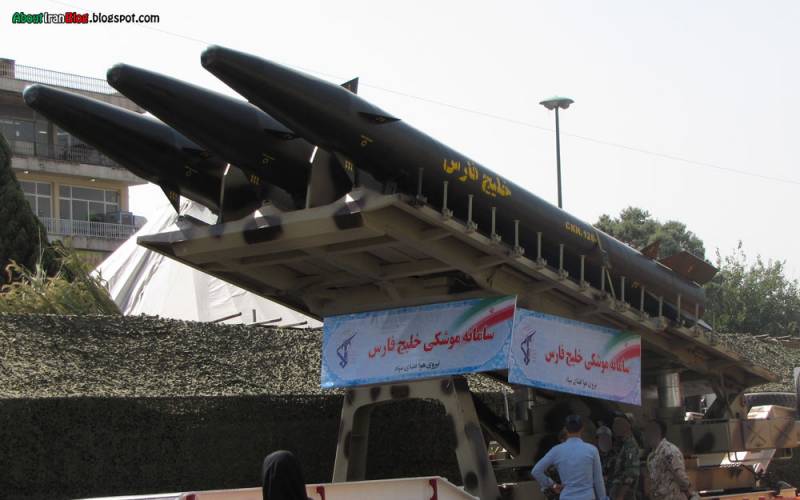
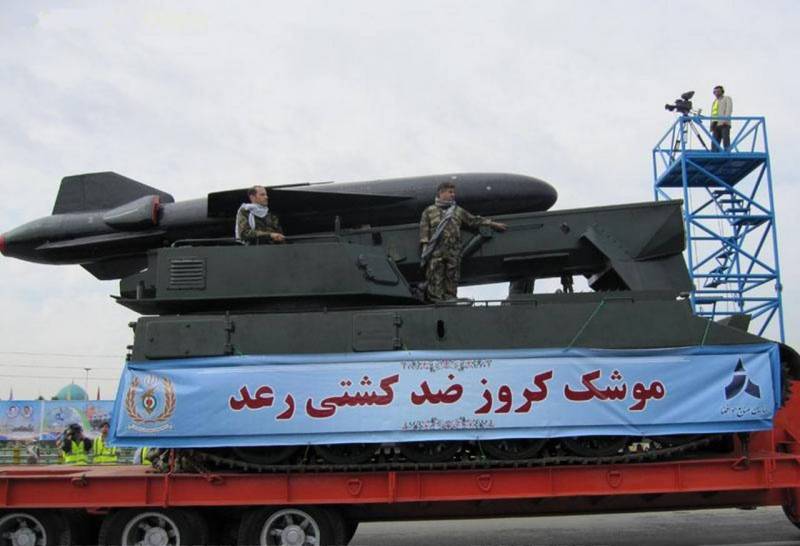
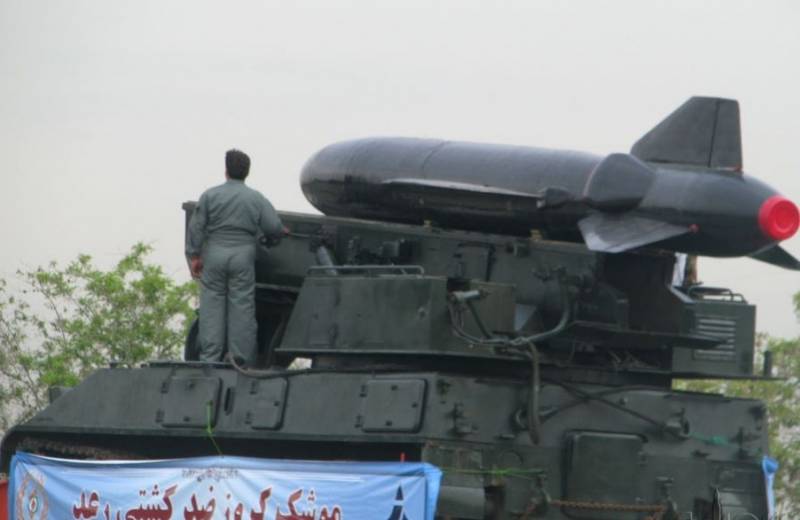
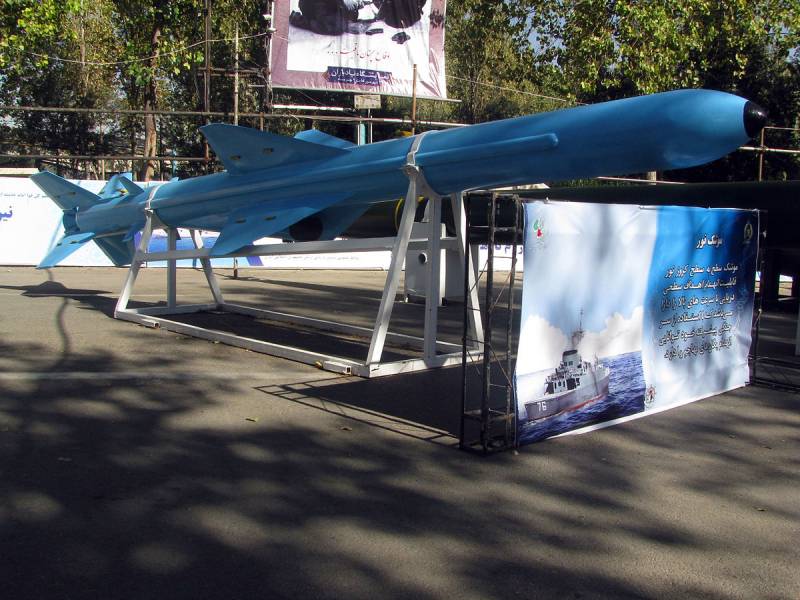
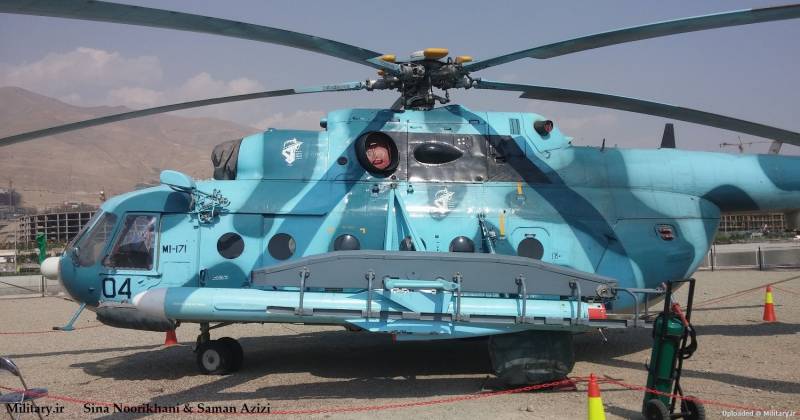
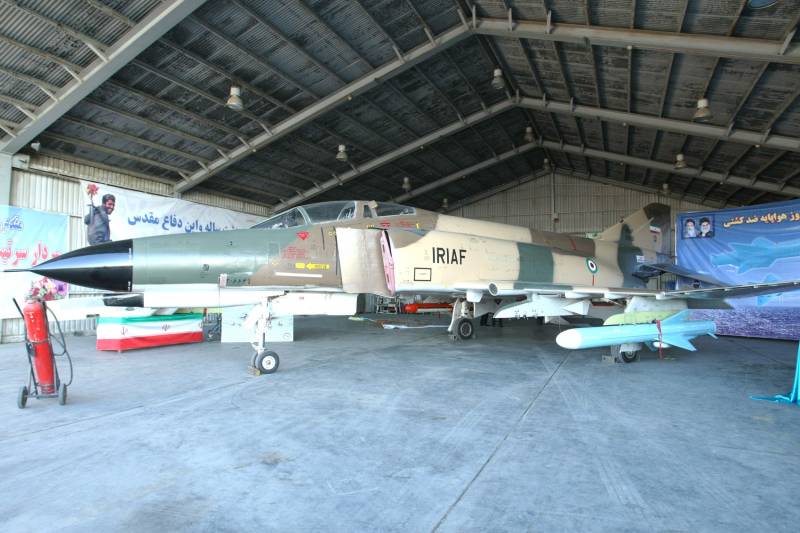
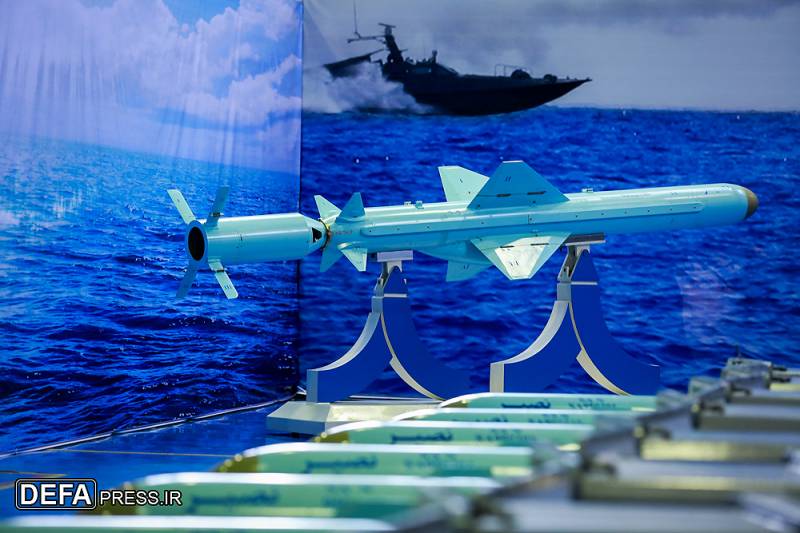
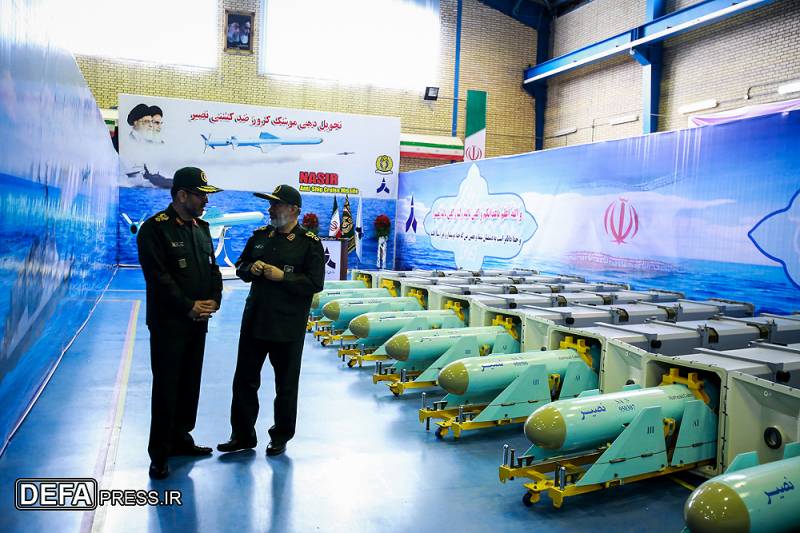
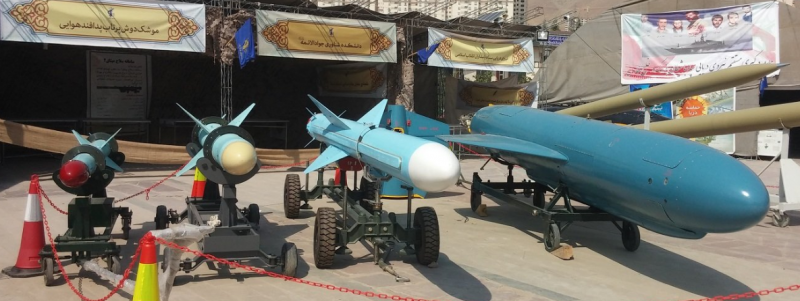
Information